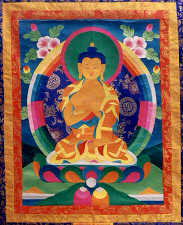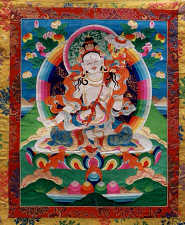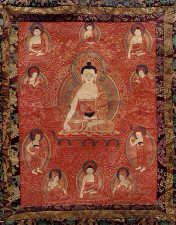| Art Q&A > Crafts |
|
|
Thangka, A Unique Tibetan Culture
Thangka has been in vogue in Tibet for centuries. In Tibetan, "Thang" means "unfolding" or "displaying", and Thangka means "silk, satin or cloth painting scroll". It is most often painted on scrolls or embroidered on wall hangings of silk or other cloth. Common at monasteries, lamas' residences, family halls for worshipping Buddha and homes of Tibetan Buddhists, Thangka is a mark of devotion to Buddhism and often serves as an object of worship.
Nobody knows where and when Thangka originated, but comparing with Tibetan painting, the history of Thangka can be traced back to as early as the Tubo period (or Songtsen Gampo period, about the 7th century), as a combination of Chinese scroll painting, Nepal painting and Kashmir painting. From the relics of Karuo in Qamdo, we can find the trace of Thangka. Until the 7th century, Songtsen Gampo united the whole Tibet and hence a new period in Tibetan history began. Later Songtsen Gampo married Nepal princess Chizun and Tang Dynasty princess called Wencheng, further strengthening the connection of politics, economy, and culture between Tibetan and the Han ethnic groups. The two princesses came to Tibet with a lot of Buddhist scriptures, architecture technology, soothsaying and lawmaking, medical scriptures and many skilled artisans, greatly stimulating the development of Tibetan society, especially the flourishing of Tibetan Buddhism and Tibetan Buddhism culture. At that time fresco alone could not satisfy the need of those disciples. So another kind of art Thangka, easy to carry, hang and collect, appeared and popularized. During the Ming and Qing dynasties (1368-1911), the central government adopted the system of approving Tibetan chieftain to strengthen the control over Tibet. These methods made contribution to the development of the Tibetan society. So the Ming and Qing dynasties saw a great progress in the development of Thangka. Thangka of this period had three characteristics: 1. Thangka in larger number; Of the existing Thangkas, most were made during the Ming and Qing dynasties.
Thangka always has a theme of Buddhism, and the artists must follow the sacred laws for portraying gods and Buddhas. Passages from scriptures are written in vermilion on the back, and Thangka is always unsigned, so it is next to impossible to know the painter and the age of ancient Thangkas.
Thangkas are usually placed upright in a rectangular shape while there are a few that deal with subjects of Mandala that are square. Cotton canvas and linen cloth are the common fabrics on which pictures are painted with mineral and organic pigments (important Thangkas use ground gold and gemstones as pigments). A typical Thangka has a printed or embroidered picture mounted on a piece of colorful silk. A wooden stick is attached on the side from the bottom to the top to make it easier to hang and roll up. Painting a Thangka usually starts by stretching a piece of cotton cloth on a wooden frame along its sides. Then, a certain type of gesso is spread over both the front and back of the canvas to block the holes and then scraped off to produce smooth surfaces. Afterwards, some orienting lines are drawn to guide the sketching. By following a fixed proportion, images are then roughly drawn. The featured deity or saint occupies the center while other attendant deities or monks surround the central figure and along the border, and is comparatively smaller in size. Next is coloring. Painters apply pigments on the sketch. Black, green, red, yellow and white are the basic colors used in coloring. All the colors are mixed with animal glue and ox bile to keep them bright. Shading is then done to produce better pictorial effects. At the final stage, facial features and eyes are finished, which is sacredly done only after a ritual held on a fixed day. After detail finishes, the canvas is removed from the frame and mounted on a piece of brocaded silk. The wooden sticks are attached to the top and bottom of the silk. After a dust cover of gossamer silk is attached it is ready to be hung up.
The common appearance of Thangka, with a scroll at the bottom, is usually 75 centimeters long and 50 centimeters wide. Besides, there is the banner style, and this kind of Thangka is 1.1 meters long and about 3.5 meters wide. According to the material, Thangka can be divided into two types: one is made of silk and this kind is called gos-thang; the other, called bris-thang, is made of pigment. The gos-thang is printed on the canvas while the bris-thang is painted on the canvas. 1. gos-thang According to the different kinds of silk, gos-thang can be divided into five classes: (1) tshem-drub-ma is made of different kinds of silk woven by hand. The largest Thangka of gos-thang kind is called gos-sku which is too big to be put on. In fact, it is only used at some special religious rituals. In the Potala Palace, there is a gos-sku with a length of 55.8 meters and a width of about 46.81 meters, made during the 5th Dalai Lama period. 2. bris-thang According to the color of the background, bris-thang can be divided into five classes: (1) tsho-thang: The background is multi-colorful. The largest bris-thang is 3 meters long and 2 meters wide while the smallest one is about 30 centimeters long and 20 centimeters wide.
Different styles of Thangka represent different schools of paintings in
Tibet: Karzhi is one of the schools of Tibetan paintings and sculptures styles. It
is said this school follows the painting style which had been used by Karma
Mikye Dorje in the Figure Measurement composed by himself and was famous for
painting calm and kind-hearted personal figures. ChenZher School is founded by ChenZher ChanMou of KhongKarLdo in Tibet. This school was born out of ManThangPa painting style and prolongs this style. 3. Mansale School The founder of Mansale School was Qiangpa-Quyang Gyel-tshap. Their painting
style is close to the ManNiang School with characteristics of boorish lines,
powerful faces, taller figures, dense color and fine painting
techniques. Karlri School was founded by the Living Buddha LanMuKar ZhaXi who combined
the technique of measurement in Tibetan painting style with those of coloring
and arrangement in Chinese painting. It has characteristics of large picture and
various contents. The personage painted usually with a comeliness and pretty
face and implicit smile. JeJuBi School is a school of painting founded by Karma Quyhang Dorje who
absorbed the painting style of Kashmir on the basis of Tibetan
painting. Manlu School is the collective name of ManNiang School and Mansale
School. It is the painting style of scholars named ChiJar and ManThangˇ¤CharKar, etc.
They had written many art books like Figure Measurement Favonian Beads,
etc. The painting style of ShiGamPa and schools that kept this painting style are
all called ShiGamPa School. It is also called Nepal School because of been
influenced by the painting style of Nepal. Deri School is a school that combined the painting style of Karlri School and
ManThangPa School. They mostly pay attention to the sculpture, expression and
connotation of the persons painted. Founded by ManlaThongZhu in the 14th century, it is the earlist painting school in Tibet. The persons painted in their works were almost with a smile or anger, with a slim and graceful figure and verisimilar expression, wearing magnificent clothes, finely colored, and the yardstick of every position of the body is moderate. |
||
All rights reserved. Reproduction of text for non-commercial purposes is permitted provided that both the source and author are acknowledged and a notifying email is sent to us. |
||
 |

 What is Thangka
What is Thangka
 Development
Development
 Content
Content

 Process
Process
 Classification
Classification

 Genre
Genre